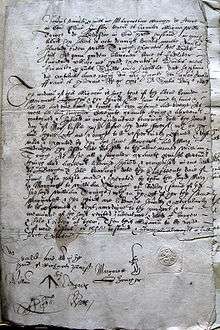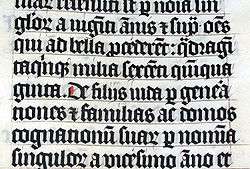Secretary hand

Secretary hand is a style of European handwriting developed in the early sixteenth century that remained common in the sixteenth and seventeenth centuries for writing English, German, Welsh and Gaelic.[1]
Predominating before the dominance of Italic script, it arose out of the need for a hand more legible and universally recognizable than the book hand of the High Middle Ages, in order to cope with the increase in long-distance business and personal correspondence, in cities, chanceries and courts. The hand thus used by secretaries was developed from cursive business hands and was in common use throughout the British Isles through the seventeenth century. In spite of its loops and flourishes it was widely used by scriveners and others whose daily employment comprised hours of writing. By 1618 the writing-master Martin Billingsley[2] distinguished three forms of secretary hand, as well as "mixed" hands that employed some Roman letterforms, and the specialised hands, the "court hand" used only in the courts of the King's Bench and Common Pleas and the archaic hands used for engrossing pipe rolls and other documents.

At the time of Henry VII, many writers began to use the "Italian" style instead, a cursive script developed from the humanist minuscule or "Roman" hand which was easier to read but also easier to forge. English ladies were often taught an "Italian hand", suitable for the occasional writing that they were expected to do.[4] Grace Ioppolo notes[5] that the convention in writing the texts of dramas was to write act and scene settings, characters' names and stage directions in italic, and the dialogue in secretary hand. The modern use of italic font stems from these distinctions.
Aside from palaeographers themselves, genealogists, social historians and scholars of Early Modern literature have become accustomed to reading secretary hand.[6]
William Henry Ireland used the secretary hand to forge many Shakespeare documents.
Two brief pamphlets provide introductory orientation: Lionel M. Munby, Secretary Hand: a beginner's introduction (British Association for Local History), 1984, and Alf Ison, A Secretary Hand ABC Book, 1990.
See also
Notes
- ↑ Scottish handwriting: Secretary hand: one hour basic tutorial.
- ↑ Billingsley, The Pen's Excellency, 1618. noted by Grace Ioppolo, "Early modern handwriting", in Michael Hattaway, ed., A New Companion to English Renaissance Literature and Culture, vol. 1 (2010:177-83).
- ↑ Cardenio, Or, the Second Maiden's Tragedy, pp. 131-3: By William Shakespeare, Charles Hamilton, John Fletcher (Glenbridge Publishing Ltd., 1994) ISBN 0-944435-24-6
- ↑ Ioppolo 2010:178f).
- ↑ Ioppolo 2010:177.
- ↑ Genealogy: Secretary hand; (University of Leicester) The Pen Room": Secretary hand
External links
| Wikimedia Commons has media related to Secretary hand. |
- Fonts at crazydiamond.co.uk
